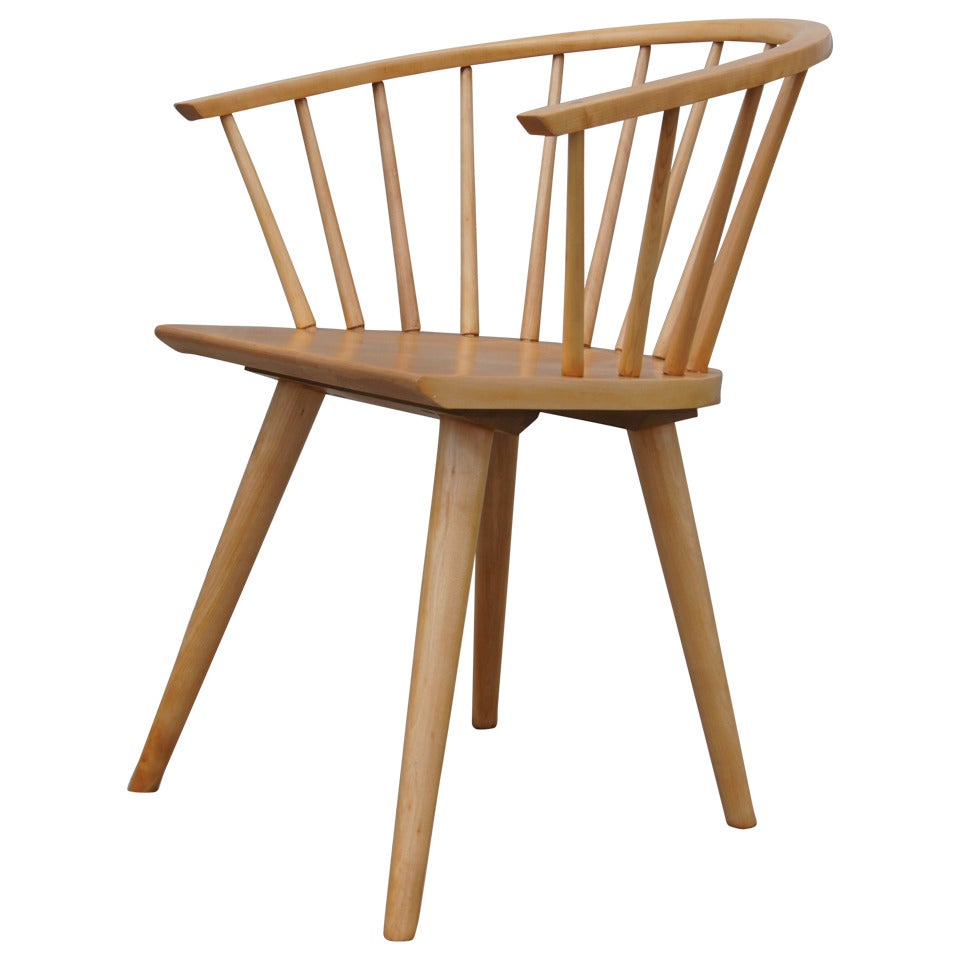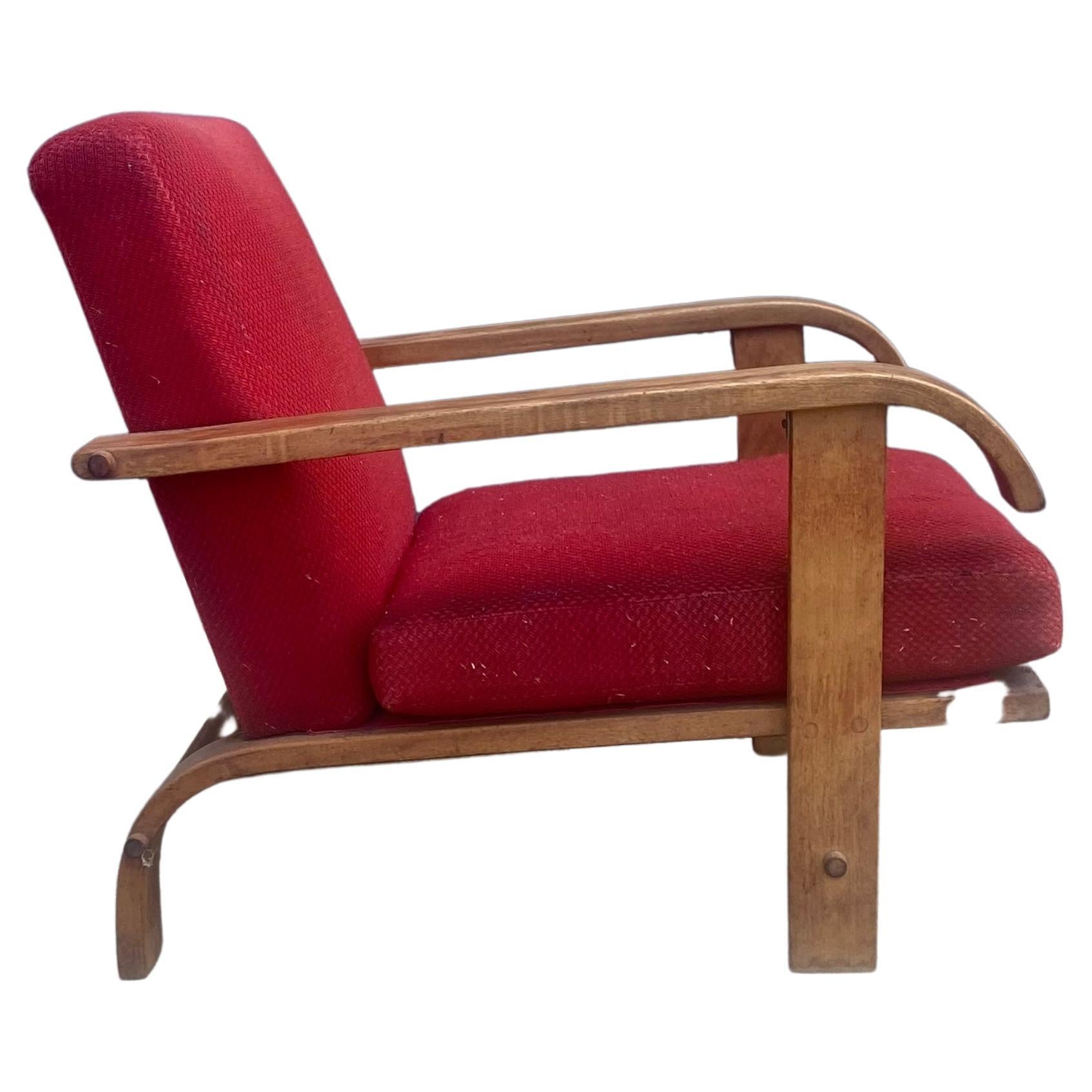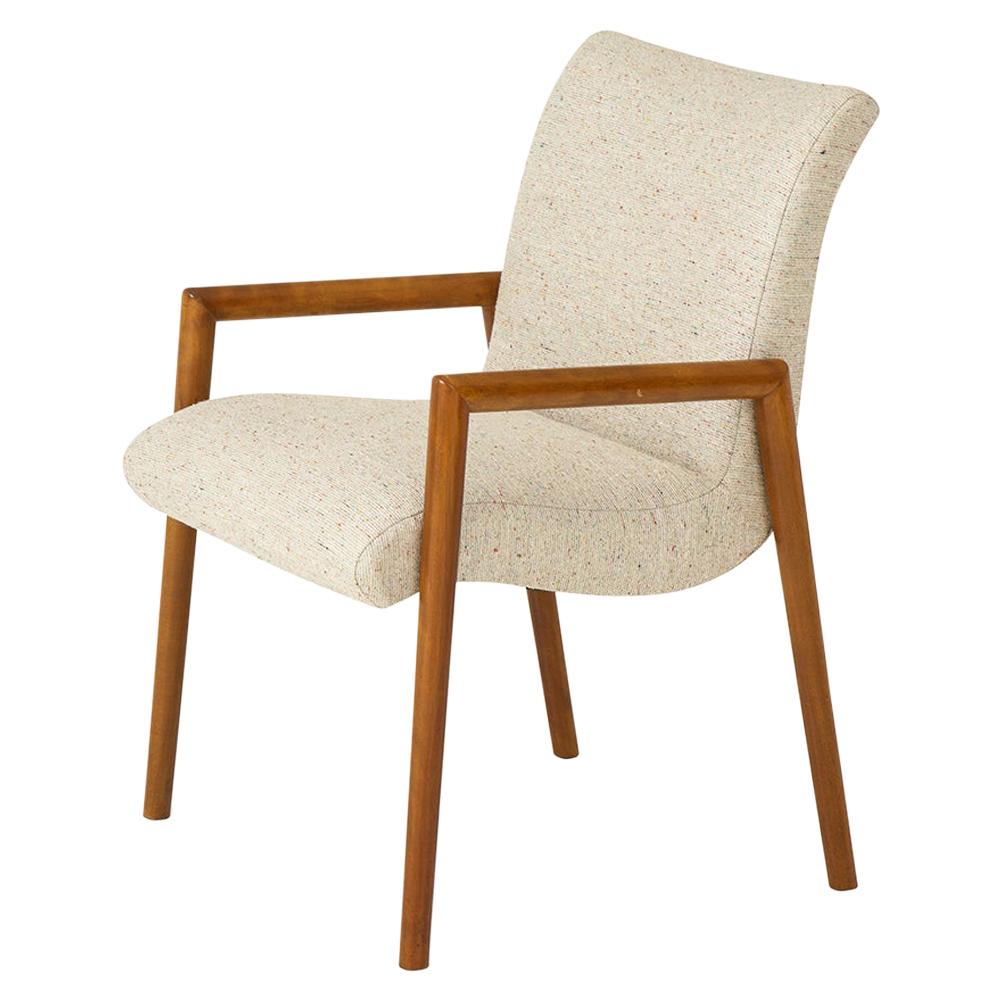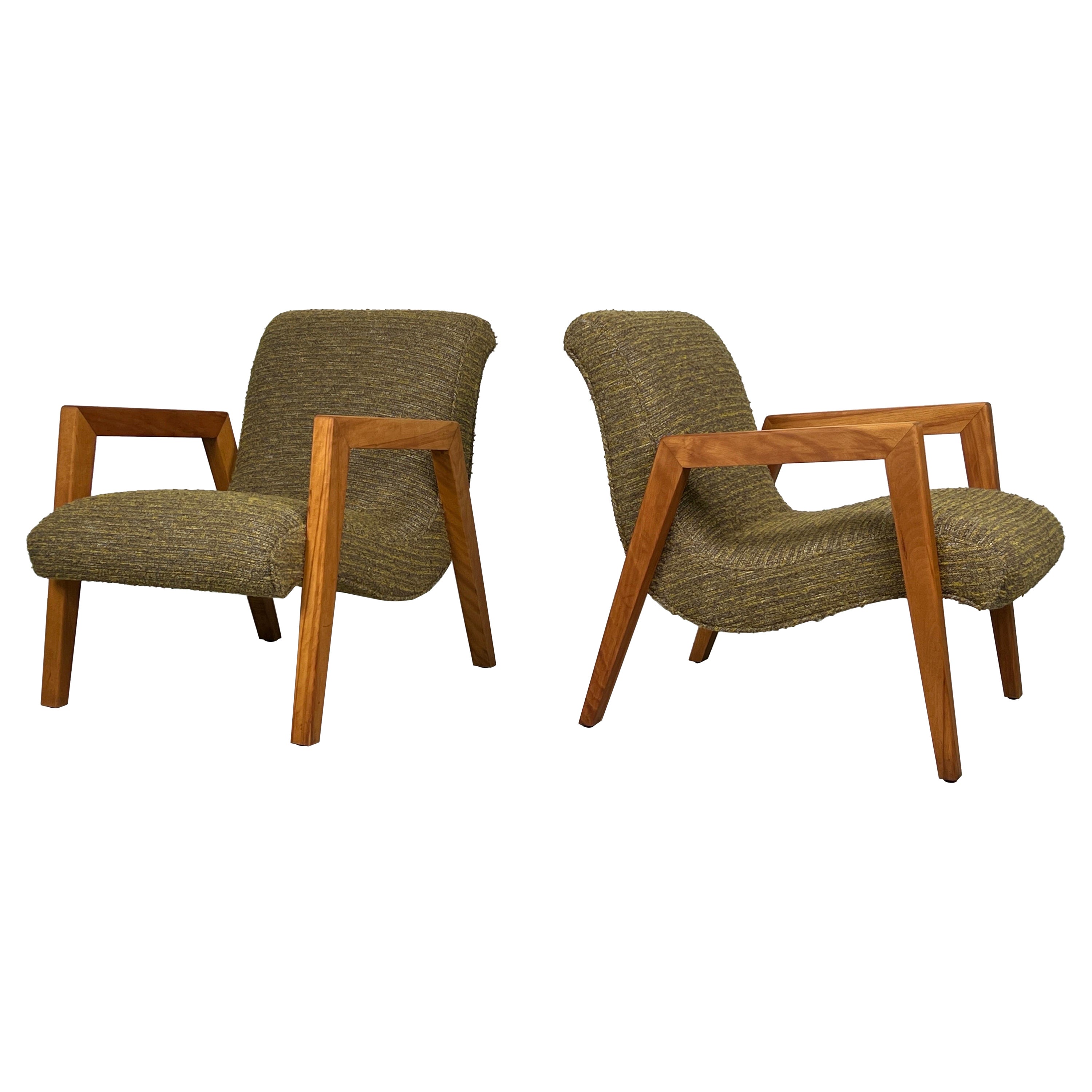1950s Russel Wright for Conant Ball Sofa Mid-Century Modern with Wooden Arms
About the Item
- Creator:Russel Wright (Designer)
- Dimensions:Height: 30 in (76.2 cm)Width: 77 in (195.58 cm)Depth: 30 in (76.2 cm)Seat Height: 17 in (43.18 cm)
- Style:Mid-Century Modern (Of the Period)
- Materials and Techniques:
- Place of Origin:
- Period:
- Date of Manufacture:1950
- Condition:Wear consistent with age and use. This Beautiful Rare Sofa by Russel Wright Is In Excellent Vintage Condition, Strong And Sturdy Construction. Upholstery Is Original With No Tears Or Holes And Can Be Used As Is With A Good Cleaning Please See Pic Of Back Of Sofa.
- Seller Location:Monrovia, CA
- Reference Number:1stDibs: LU7531231246452
Russel Wright
While industrial designer Russell Wright may be known to modern furniture enthusiasts for his streamlined end tables, dining chairs and other pieces, he is universally revered for a line of tableware he created called American Modern. Efficient, practical, and striking in their elegant forms and warm colors, the American Modern ceramic pieces, which included bowls, pitchers, dishes, and other items, became the best-selling dinnerware of all time. Today, vintage Russell Wright American Modern tableware is an evergreen favorite of art collectors and interior designers alike.
Born in 1904 in Ohio, Wright was surrounded by inspiration for the furniture he would one day design. He was raised in a Quaker household and grew up with the spare, meticulously handcrafted furniture for which the Quakers are known. As a young man, he studied art and sculpture at the Art Academy of Cincinnati and the Art Students League of New York, going on to study law at Princeton University in New Jersey. But Wright loved the arts and abandoned his pursuit of a law degree to create stage sets in Princeton and Paris alongside fellow noted designer Norman Bel Geddes.
In 1927, Wright married artist and sculptor Mary Einstein. Together, they moved to New York City, where Wright began to create sculptures. Mary convinced him to create metal bookends from his sculptures, and later, when he began to craft bar accessories from chrome, he turned to aluminum, a much cheaper material for the purposes of mass production (his barware was eventually included in the "Machine Art" show at the Museum of Modern Art in 1934, which was curated by Philip Johnson).
Mary worked on marketing Russell's products, successfully proposing everyday uses for Wright's beautifully designed housewares. She is said to have been a pioneer in the world of lifestyle marketing, coining the terms "American Modern" and "blonde" to describe the charming, light-colored maple furniture he created for Conant Ball, which was known at the time for its reproductions of American Colonial furniture.
While Wright had created some Art Deco furnishings for Heywood-Wakefield, it was this group of bedroom furniture for Conant Ball that got its name, American Modern, from Mary. Under her guidance, Wright's attractive, functional designs for the home gained renown, leading to commissions by prestigious companies like the Steubenville Pottery Company.
In 1935, Wright formed Russell Wright Associates with Irving Richards, an entrepreneur who had worked with Lightolier and would later establish Raymor. In collaboration with Richards, Wright debuted the first line of American Modern dinnerware in 1939, which was initially produced by Russell Wright Associates and then manufactured by Steubenville for two decades. The line sold over 200 million pieces during its 20 years of production. In 1955, Wright was selected by the U.S. State Department to research handicraft industries in Southeast Asia, a trip that influenced his later designs.
Throughout his life, Wright continued to design furniture and housewares, with the works' signature earth tones, curved forms, and clean silhouettes of his floor lamps, lounge chairs, and serveware remaining popular staples in American households. In his later years, he focused on designing and building his home, Manitoga, and working with the National Parks Service to develop the "Summer in the Parks" program.
Upon Wright's death in 1974, Manitoga was given to the Nature Conservancy. It was declared a National Historic Landmark in 2006 and today houses the Russell & Mary Wright Design Gallery, where many of Wright's works stand on permanent display. In 2011, stamps from the U.S. Postal Service featured Wright's image as one of the United States' twelve most influential industrial designers.
Find vintage Russel Wright lighting, seating, tables, serveware, ceramics and glass on 1stDibs.
- ShippingRetrieving quote...Ships From: Upland, CA
- Return PolicyThis item cannot be returned.
- 1950s George Nelson Steel Frame Sofa by Herman Miller Vintage Mid-Century ModernBy George NelsonLocated in Monrovia, CAGuaranteed 100% Herman Miller George Nelson steel frame sofa. Vintage George Nelson steel frame sofa by Herman Miller 1950s all origi...Category
Mid-20th Century American Mid-Century Modern Sofas
MaterialsSteel
- 1950s Vintage Mel Bogart Daybed for Felmore Sofa DaybedBy Mel BogartLocated in Monrovia, CAFELMORE low slung sofa daybed 1950s Designed by Mel Bogart. Vintage 1950s Daybed Designed by Mel Bogart for FELMORE Daybed. Classic Mel Bogart Design. Sleek Clean Lines. Original Upholstery, Signed With Label On The Wood Frame. Mel Bogart Daybed Sofa Is In Excellent Condition. The Wood Frame Has Gentle Vintage Ware...Category
Mid-20th Century Mid-Century Modern Daybeds
MaterialsMetal
- RARE Hard Rock Maple Conant Ball American Modern Art Deco Desk with Round PullsBy Russel WrightLocated in Monrovia, CA1940s Russel Wright Conant Ball American Modern Solid Hard Rock Maple Art Deco Round Pull Desk Very RARE. This RARE Solid Hard Rock Maple Desk With Roun...Category
Mid-20th Century American Mid-Century Modern Desks
MaterialsWood
- Kai Kristiansen 4 Pc Danish Sofa Magnus Olesen Excellent Condition Denmark 1950sLocated in Monrovia, CA1950s Kai Kristiansen Danish Rosewood 4 piece sofa For Magnus Olesen Made In Denmanrk. Beautiful Rosewood, And Red Upholstered Seating. Each Chair Or Section Has It's Own Rosewood Frame With It's Own Magnus Olesen, Durup Denmark Label. This 1950s Kai Kristiansen Magnus Olesen 4 Piece Sofa Is Very Flexible In It's Various Sectional Placements. For Instance, A Nine Foot Sofa or A Love Seat And 2 Side Club Chairs or A 3 Seat Loveseat With 1 Side Chair or Separate The Sofa With A Danish Table Between or... Do You See Where This Is Going. The Possibilities Are Many.. approx 9 foot sofa...Category
Mid-20th Century Sofas
MaterialsUpholstery, Wood
- 1940s Russel Wright Art Deco Hardrock Maple Spun Aluminum Torchiere Floor LampsBy Russel WrightLocated in Monrovia, CARare 1940s Russel wright hardrock maple and spun aluminum torchiere floor lamps Art Deco Mid-Century Modern. Beautiful rare pair of Russel wright torchiere...Category
Mid-20th Century American Art Deco Floor Lamps
MaterialsAluminum
- 1960s Vintage Wendell Castle Molar Sofa White Fiberglass Organic Mid-CenturyBy Wendell CastleLocated in Monrovia, CA1960s Vintage Wendell castle molar sofa white fiberglass organic midcentury Beautiful fiberglass molded settee by Wendell castle from the 1960s. ...Category
Mid-20th Century American Mid-Century Modern Sofas
MaterialsFiberglass
- Russel Wright for Conant Ball Young American Modern Mid Century Dining ChairBy Conant Ball, Russel WrightLocated in Countryside, ILRussel Wright for Conant Ball Young American modern mid century dining chair Chair measures: 16.5 wide x 19.5 deep x 31.25 high, with...Category
Vintage 1970s American Mid-Century Modern Dining Room Chairs
MaterialsUpholstery, Wood
- Maple Chair by Russel Wright for Conant BallBy Conant Ball, Russel WrightLocated in Dorchester, MARussel Wright designed this solid maple armchair for Conant Ball, inspired by the round frame and spindles of the classic American Windsor. One chair remains available.Category
Vintage 1950s American Mid-Century Modern Dining Room Chairs
MaterialsMaple
- Russel Wright Easy Chair for Conant Ball's, American Modern, 1935By Russel Wright, Conant BallLocated in Buffalo, NYRare Art Deco easy chair designed by Russel Wright for Conant Ball American modern in 1935 ,solid maple contraction with original cushions retains original finish ,patina..,, signed ...Category
Vintage 1930s American Art Deco Lounge Chairs
MaterialsUpholstery, Maple
- Modernist Armchair Designed by Russel Wright for Conant Ball, circa 1950By Russel WrightLocated in Philadelphia, PAA modernist armchair designed by Russel Wroght for Conant Ball, circa 1950.Category
Vintage 1950s American Mid-Century Modern Armchairs
MaterialsWood
- Russel Wright Spindle Back Rocking Chair for Conant BallBy Conant Ball, Russel WrightLocated in Miami, FLSpindle back maple wood rocker designed by Russel Wright and manufactured by Conant Ball.Category
Mid-20th Century American Mid-Century Modern Rocking Chairs
MaterialsMaple
- Pair of Russel Wright Lounge Chairs for Conant BallBy Russel WrightLocated in Dallas, TXA pair of maple framed lounge chairs by Russell Wright for Conant Ball.Category
Vintage 1950s Lounge Chairs
MaterialsMaple






